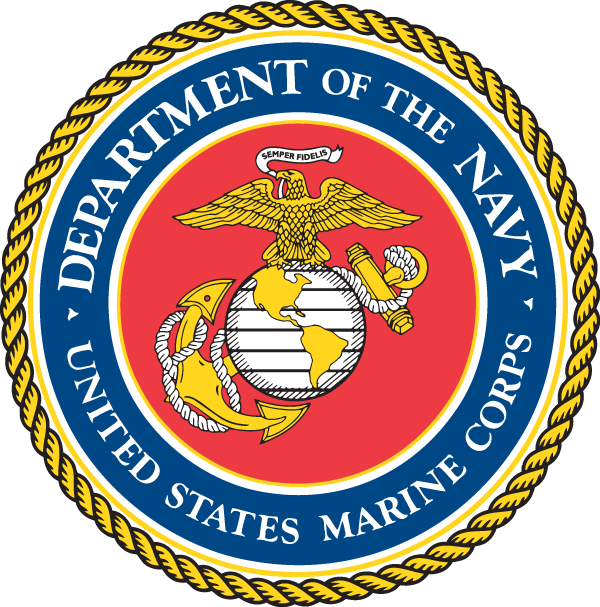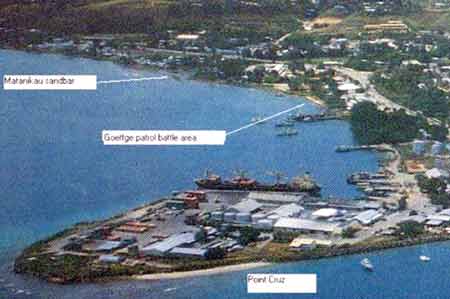Colonel Frank B. Goettge
 U.S. Marine Corps, 1st Marine Division, G-2 Intelligence U.S. Marine Corps, 1st Marine Division, G-2 Intelligence
Missing In Action (MIA)
Background
Frank Bryan Goettge was born to parents Adam Johannes Goettge and Caroline Rausch on December 30, 1895 in Salem Township of Tuscarawas County, Ohio. The family name Goettge is pronounced "Get-Chee". He attended Ohio State University and played football.
World War I
 On May 22, 1917 Goettge enlisted in the U.S. Marine Corps (USMC) and received basic training at the Philadelphia Navy Yard. Next, assigned to a detachment of Marines aboard USS Vermont (BB-20). On October 9, 1917 promoted to the rank of Corporal. On December 19, 1917 promoted to
Sergeant. By March 1918 he was the senior enlisted man in his detachment. Afterwards, assigned to the Marine Barracks at Quantico, Virginia, for officer training and by July 1918 commissioned as a Second Lieutenant with serial number 333 (later became serial number O-000333). Next, sent to staff school at Quantico's Overseas Depot. On May 22, 1917 Goettge enlisted in the U.S. Marine Corps (USMC) and received basic training at the Philadelphia Navy Yard. Next, assigned to a detachment of Marines aboard USS Vermont (BB-20). On October 9, 1917 promoted to the rank of Corporal. On December 19, 1917 promoted to
Sergeant. By March 1918 he was the senior enlisted man in his detachment. Afterwards, assigned to the Marine Barracks at Quantico, Virginia, for officer training and by July 1918 commissioned as a Second Lieutenant with serial number 333 (later became serial number O-000333). Next, sent to staff school at Quantico's Overseas Depot.
Afterwards, assigned to the 6th Separate Battalion at Pontanzen Barracks near Brest, France. After several weeks of training, promoted to First Lieutenant and was assigned to Company G, 5th Marines when World War I ended on November 11, 1918. He was part of the Army of Occupation in Germany under the commanded by Captain Lemuel C. Sheperd, Jr. and played on his division's baseball team. He was "injured in the line of duty" while with the team and sent back to New York in September, 1919.
Interwar Period
In 1920, Goettge joined the First Provisional Brigade in Haiti. He began making a name for himself as a scouting and intelligence officer, as well as a company commander. During this time he also applied for aviation training at Pensacola, but a persistent medical issues resulted in his rejection in September, 1921.
Goettge was recruited by the Marine Corps football team and played as a defensive back nicknamed "The Great Goettge." The team had a record of forty victories and two ties. As a player, he earned national acclaim, and several professional teams expressed their interest in possibly signing him as a professional football player. Sports reporter Walter Camp described him as "easily the greatest football player of the present day - the nearest approach to Jim Thorpe of all time."
Meanwhile, between 1921–1924 Goettge served in various staff functions at Quantico. In March, 1927 assigned to the America Legation in Peking (Beijing) in China as the detachment athletic officer. In March 1929 promoted to Captain and returned to Quantico in September before assignment to Headquarters, USMC in Washington in January 1930. Goettge was assigned as the aide-de-camp to Major General Wendell Neville, Commandant of the Marine Corps. Goettge served as his aide until the general's sudden death on July 8, 1930. Next, he assisted the next commandant, Major General Ben H. Fuller and was assigned as an s aide to the White House until June 1933.
Next, Captain Goettge became commander of the Marine detachment aboard USS Pennsylvania (BB-38). In June 1935, he took over the detachment on the USS Reina Mercedes (IX-25) a training ship at Annapolis and served as the commander and provost marshal. In June 1936 promoted to Major then returned to Quantico, where he studied at school senior course. By June 1938, he was second in command of the basic school at the Philadelphia Navy Yard, when he was a recruit. In August, 1940, promoted to Lieutenant Colonel, serving under Colonel Clifton Cates.
World War II
During July, 1941, assigned to the 1st Marine Division (1st MARDIV). During 1942, Goettge was assigned to Headquarters Company as Chief Intelligence Officer when the Division was sent overseas to Wellington in New Zealand for training then departed for the first U.S. offensive against the Japanese in the South Pacific. While at sea, promoted to the rank of Colonel although he lacked any combat experience and had no real intelligence experience aside from his time on Haiti.
Guadalcanal Campaign
On August 7, 1942, U.S. Marine Corps (USMC) 1st Marine Division made an amphibious landing at Red Beach on Guadalcanal. Immediately, Goettge and his men set about gathering and analyzing information about the enemy and studying captured Japanese material and equipment around Lunga Point Airfield (Henderson Field). Ashore, the Intelligence staff realize their maps and knowledge of the island was extremely limited.
On August 12, 1942 a patrol from the 3rd Battalion, 5th Marine Regiment, captured a Japanese soldier named Sakado who was found foraging in their area. During interrogation, the Prisoner Of War (POW) believed Japanese forces west of the Matanikau River were a disorganized, demoralized, low on food and in poor health and he believed they could be convinced to surrender. Gottege believed the prisoner and ordered First Sergeant Steven Custer to organize a patrol to capitalize on this intelligence.
Goettge Patrol
The "Gottege Patrol" would include a force of 25 Marines led by Col. Gottege with an interpreter, a doctor, a good portion of the intelligence section plus riflemen that would land by boat at a beach were a white flag had reportedly been seen. Ashore, they planned to convince the Japanese to surrender and walk back to Marine perimeter the next day. At 6:00pm the patrol departed Kukum with POW Sakado led with a rope around his neck. Unable to land at the orginal site due to the tides, the force instead made for an alternate location. Despite warnings from Lt. Colonel Bill Whaling and the prisoner, Gottege approved the landing roughly 200 yards west of the mouth of the Matanikau River but the boat became stuck on a sandbar and had to be man-handled ashore and allowed anyone ashore to see and here their arrival.
Ashore, a Japanese force from the 2nd Platoon, 11th CU Security Force led by
Lt. Soichi Shindo observed their arrival and when the Marines advanced inland they opened opened fire. Immediately, two shots hit Col Goettge who was hit in the head and died and seriously injured First Sergeant Steven Custer. The two Marines who crawled forward to check on the men recovered Goettge's insignia and wristwatch. Before dawn, the entire patrol had been wiped out aside from three survivors who managed to swim back to friendly lines one at a time. They reported seeing Japanese swords "flashing in the sun" as they fell upon the wounded and dead.
Afterwards, the bodies of the dead were never recovered. There were accounts of knowing where they were and that they had been thrown into fighting trenches and covered up. There were at least three reports over the following weeks that the bodies were partially buried in the sand with limbs sticking out of the ground. One report, made by a Marine years later stated he was on patrol at the scene of the slaughter and personally saw the mutilated bodies of Goettge patrol including a decapitated torsos and boots with limbs still attached. But no bodies were ever recovered.
Afterwards, the ill fated "Gottege Patrol" became synonomous
with the brutality of Japanese. In turn, it helped to fuel American
brutality against the Japanese and the Guadalcanal campaign developed into the rule of "kill or be killed". Officially, the incident was not reported partly due to censorship during the war and to spare relatives details about the incident.
Memorials
Goettge was officially declared dead on August 13, 1943 and remains listed as Missing In Action (MIA). Over the decades, there have been several unsuccessful attempts to locate the Marines from the Goettge Patrol without results.
Goettge earned the Legion of Merit with Combat "V" for valor device, Purple Heart, posthumously, Combat Action Ribbon, American Defense Service Medal, Haitian Campaign Medal, Marine Corps Expeditionary Medal, Asiatic-Pacific Theater of Operations Campaign Medal with one bronze campaign star (Guadalcanal), World War I Victory Medal with "France" Bar, World War I Army of Occupation Medal, World War II Victory Medal and Navy and Marine Corps Presidential Unit Citation Ribbon.
Goettge is memorialized at Manila American Cemetery on the tablets of the missing. He also has a memorial marker at Standing Rock Cemetery in Kent, OH.
During 2001,
Goettge was inducted into the Marine Corps Sports Hall of Fame.
References
American Battle Monuments Commission (ABMC) - Frank Bryan Goettge
FindAGrave - Col Frank Bryan Goettge (photos)
FindAGrave - Col Frank Bryan Goettge (memorial marker photo)
The Village - Story of the small village on the Mataniko (Matanikau) and the Goettge Patrol, as told from Solomon Island, Japanese and Marine perspectives by John Innes
Jack Clark USN Lunga Boat Patrol and Beachmaster
"…Tonight a small raiding part left to go down into Jap territory to ask for the surrender of all remaining Japs. They had one prisoner who volunteered to take them down, an interpreter and about 20 men."
Missing Marines - Frank B. Goettge
Guadalcanal's Longest Fight (2025) pages 7-8, 10, 20-23, 26, 33, 35, 38, 49, 209 (footnote 13), 234 (index Goettge, Medal of Honor), 236 (index Medal of Honor)
Contribute Information
Do you have photos or additional information to add?
|






